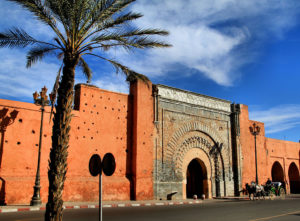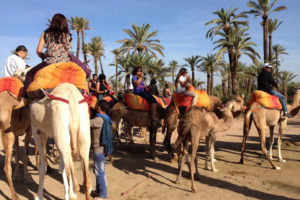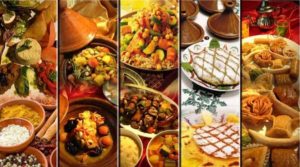(A personal Experience)!
The Kingdom of Morocco’s major city in Marrakesh. After Casablanca, Fez, and Tangier, it is the fourth largest city in the country. It is the capital of Marrakesh-Safi’s southwest region. Marrakech is situated 580 km southwest from Tangier, 327 kilometres southwest of the Moroccan capital of Rabat, 239 km south of the Casablanca, and 245 km (153 mi) north-east of Agadir, at the foothills of the Atlas range. Styrofoam lesion the southeast of the Moroccan capital of Rabat.
Marrakech is probably the second most important city after Fez in Morocco. Since the Neolithic era, the area is populated by Berber farms, but in 1062 the present town was founded by the leader and cousin of King Yusuf ibn Tashfin Abu Bakr ibn Umar, Almoravid. In the 12th century, the Almoravids founded several madrasas and mosques in Marrakech which were inspired by Andalusia. The town has been given a nickname “Red City” or “Ochre City” thanks to the city’s red walls, designed by Ali ibn Jusuf in 1122-113 and many buildings made of red sandstone during this period. To be the social, religious and trade facility in the Maghreb and sub-Saharan Africa, Marrakesh quickly developed and established itself; Jemaa el-Fnaa is the busiest place in Africa.
The temperature in Marrakech:
Marrakech dominates by a warm semi-arid climate (Köppen climate gradation BSh). In winter, the average temperature ranges from 12 ° C (54 ° F) to 26–30 ° C in summer. (79–86 ° F). The precipitation trends observed in Mediterranean climates are seen in relatively wet winters and dry summers. Nevertheless, the town receives less rain than usual, resulting in a semi-arid weather category, in a Mediterranean climate.
The average precipitation of the city between 1961 and 1990 was 281,3 millimetres (11,1 in) a year. Barrows says of the climate that “Marrakech is often characterized as a desert in nature. But to one familiar with the southwestern part of the United States, it doesn’t indicate a desert but a zone of seasonal precipitation, in which humidity moves underground, not soils.
The position of Marrakesh on the north side of the Atlas is not a southern one. But it is still the northern focal point of Saharan communications and its history, its types of people, its trade and the arts all link to the broad Southern Atlas areas that reach into the Sahara Wilderness.
Marrakech Tour Souks:
The souks of Marrakech (covered markets) form the teeming and confounding subconscious of the city, an extensive network of streets frequently permeated with sunshine. There is a specific specialty for every Marrakech souk, including rugs, leather goods, spices, metalworking or clothes. The first price that the dealer listed is generally a great multitude of what they expect. Haggling is necessary. French is easy but money talks and traders know that English always speaks.
The product range includes simplistic screams and complex show rituals served with steaming tea. You’ll consider one of the largest collections of tapestries in the world to explore your luggage allowance. More lightweight options include sleek tea glasses, strange “Slippers” shoes, brass lanterns, serving platters, chess sets, and baskets.
At Djemaa el Fna’s Northern end, the Marrakech souks start. Once you are inside, simply watch the narrow, labyrinthine alleys at will and find it a fortunate bonus if you exit where you are inside!
In Marrakech, the disappearance of souks is one of the most iconic things you can do. A souk is a marketplace for Arab people. Marrakesh Souks are the largest in Marrakech and the perfect shopping spot for your travel souvenirs. In the little streets of the Medina in Marrakech you will find the souks; the walled medieval Centre. You will be lost among the winding streets when you reach the Medina, do not try to resist, embrace the shops, and you will find the most fascinating souks in Marrakech.
When local people can see that you’re lost, it may be helpful to hit them to help you but just remember they’ll ask for an additional charge as soon they’ll drive you to your destination. If you need no assistance, respond with a friendly “no thanks” and proceed. Make sure you haggle if you do a shop in the souk! Negotiation is a big part of souks shopping, you’re overpaid if you consent to their first offer! You have rumored that the initial price they quote you might be as low as 1/10th and it still was a fair price, but I never managed to make it to less than half personally. If you want more advice in Morocco for what to buy and how to sell.
Finding Out the Real Price of things:
Very few things you can buy in Morocco are exclusive to you. In almost every store, in any souk, in every city in Morocco, the same bags, tapes, and blankets are available. There are differences in color and price, but it is quite easy to find out which goods should be cheaper due to the sheer number of similar products sold.
Please spend a day price testing before you buy something. The shops near busy main squares usually cost you more, whereas the shops down small side alleys typically are cheaper. We rent more and pass the cost to the consumer. Just get a lay country, don’t even start negotiating yet.
For example, colorful woven towels with cups in Essaouira are very common for purchases on the ends. You will find that the initial price you ask for is 120 Dhs (~13) $if you search their price near the square. But the more you walk in the souk, the more you lower the price. First to 100 Dhs, and eventually to 80 Dhs (the last value I bought).
Negotiating in Marrakech:
Negotiations are planned and accepted in Marrakech to be prepared to negotiate with the merchants. Remember that prices are not specified on products (including in the smaller foodstuff markets of the souks), so ask the owner of the shop how much you want to purchase. You will find it takes a moment for them to give you a rate–they presumably size you. We had many shop owners telling us that they charge “poor people with money” 3 times higher.
You will also find that the price will drop a little as soon as you say no and start walking away. “How much are you paying, they’ll call after you?” I give a special rate for you!
Some Negotiating Tips:
Walk away (or pretend at least to start walking away).
Have a number in mind that you are prepared to spend (and a number that you are NOT ready to spend).
Counter proposal at a rate of roughly half the initial offer cost.
Have fun doing this!
Don’t buy from anyone who is too violent or rude.
Say, the price starts at 400 Dhs(~ $43), and 200 Dhs. You can almost immediately tell you exactly how far you are on or off. You would probably end up in the center somewhere, say about 300 Dhs if you act insulted but proceed with negotiations. They aren’t interested in budgeting if they just pull the head “no” and don’t worry.
Quality checking:
Each owner of the shop gives you a game of anything you pick. “Good quality, leather camel or handmade.” “Hand-made.” Don’t believe what you hear. Don’t believe what you hear. You will have to test yourself thoroughly!
Things to buy in Marrakech:
Leather Poufs:
These broken leather cushions are a common souvenir that can be purchased in Morocco because they cannot be packed in small quantities to match your luggage. They are also available for about 6 times the price you pay here in small boutiques in the US.
The cost of a pouf depends on the quality and quantity. The smaller, painted poufs run about 150 Dhs, while the bigger, brown leather poufs run around 300 Dhs. It’s easy for you to darken with oil if you don’t like the color but don’t light it up).
Leather Bags:
Leather bags vary widely in size and quality in Morocco, so it’s very hard to direct what you’re going to be waiting for.
In Morocco, I bought a bag with a flexible belt to make it a collision or a bag cross-body. The coir is cross-mounted and likely has a width of 12′′ by 6′′. The value was quoted as 350 Dhs when I first saw it. As I returned later in the day, another man was working at the shop and he quoted 700 Dhs for me (twice the same bag exactly). She yells lower numbers at me I’ve scoffed and gone away with him. Finally, on 200 Dhs we settled.
Different towns have several gems, so don’t move into a new city that you want to explore unless you find something you love. Just buy it or later you’re going to regret it!
In Marrakech, we hope you have an incredible time shopping!
For other information about Marrakech travel guide please visit Kayak Website



